|
Gray Water Containment Tank
Also known as "Big
Blue"
Larger Recreational Vehicles usually
have 3 water tanks:
1. Fresh water; 2. Black Water (toilet
sewage) 3. Gray Water (sink sewage)
Yes, most states consider the water that
drains from our sinks as sewage. As an example, in Florida, gray water is
considered water from handwashing sinks, tubs and showers. Kitchen sink
waste is considered to be blackwater, due to it's high concentration of solids.
While we as pop-up campers may not think
of it that way, most states do have laws which control where and how used water is stored, transported and disposed of. Understand the laws in
the state and area you camp in. If in doubt, ask park management. Florida
Policy on "Transportable Wastewater Containers".
Still confused over what gray water is? Click Here
As Pop-Up Campers usually have a single tank
which contains fresh water other methods of storage and transport must be used
to safely dispose of it.
Florida DOH amends policy on use of
transportable wastewater containers and cassette toilets. Read all
about it!
All photos are thumbnails,
click to see an enlarged version
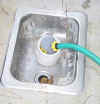 |
Of course,
the easiest way to dispose of gray water is to always camp on
water/electric/sewer sites with the "big boys". The photo
to the left shows the sewage drain on a campsite at Fort
Wilderness in Walt Disney World. Simply run a hose form the gray
water drain on your pop up (mine is pictured in the photo below) to the
sewer drain on the campsite. Be advised that these sewer drain
openings come in about 6 different configurations, so you may never know
which one you are going to run into. Drop by your friendly
camping/RV store and they sell adaptors which will work with most
systems. The gray plug in the photo is one of those
adaptors that I always carry. Figure $10 - $15 to pick up the
adaptors you need.
|
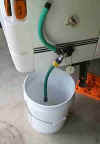 |
For many years, all we used was a bucket to
catch the water as it drained out of the pop-up. The photo demonstrates this method of containment. Unfortunately,
unless you are extremely careful the bucket can overflow and/or spill
while being transported to a designated dump site.
|
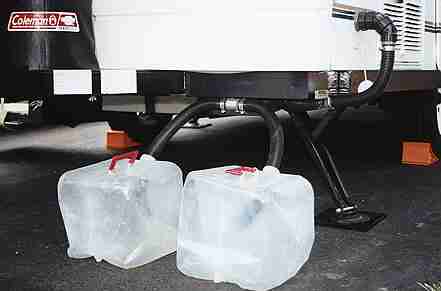
Check out Bill's
Webshots page for more great information on his grey water system as
it changes
|
Bill uses 5 gallon collapsible
containers. He describes them as inexpensive to buy, inexpensive to
replace when they get grungy inside, easy to see when they're full since
they're translucent, easy to store since they collapse and take up next to
no room to store, easy to lift into the van for a trip to the dump station
(no matter how far away it is!), and essentially endless capacity by just
having a couple of spares on hand! The photo to the left shows
his original design which did not incorporate any venting.
It should be noted that the usage of these types of
solutions may not be approved in all jurisdictions.
|
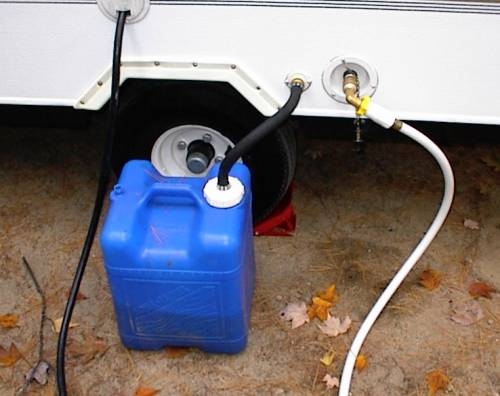 |
To the left is the gray water container Lee uses.
it is adapted from a standard 7 gallon water bottle. Click on the picture
to go to Lee's website! |
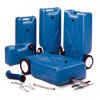 |
Gray water tanks are commercially available
in many sizes to sit your waste water needs. Shown to the right are
5, 10, 15, 22 and 30 gallon tanks. |
 |
The tank to the left
is a 22 gallon tank with wheels for easy transport to a dump
station. The labeled parts are as follows:
1. Drain connection (for use at dump station)
2. Fill connector
3. Large wheels for transport
4. Drain hose
5. Fill hose
6. Trailer hitch adaptor
All parts are standard and are provided by the manufacturer. |
 |
The photo
demonstrates how to
utilize the tank: loosen the drain connection (#1 above) slightly as an
air vent and connect the fill hose (#5 above) between the fill connector
on the gray water tank and the drain on the side of your pop-up. It
should be noted that some pop-ups have this drain connection under the
pop-up, not on the side. In 2004 I changed out the drain hoses from
5/8" garden hose to sump pump hose. You can check out my new
"Gray Water Drain" |
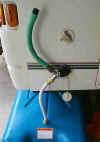 |
Venting
Some people find that the sink drains quicker if you place a
"vent" in drain line. Use a standard hose "Y"
adaptor and be sure to raise the vent sufficiently so that the drain water
is not able to exit this hose. |
 |
An
accessory level indicator is available from Barker. This allow you
to see the level of the gray water without having to open the container. |
 |
Transport
The supplied trailer hitch adapter slips into the handle of the gray
water tank and then over the ball of your trailer hitch. You should
not drive over "walking" speed or damage may occur to either the
tank or wheels.
You should transport in a manner which will preclude the leakage of the
contents of the tank. Be sure that BOTH caps are
secured prior to moving the tank! |
 |
Towing
Close up - Trailer hitch
adaptor
|
 

|
Disposal
Once full, or at the end of your camping trip, transport the tank to a
state approved waste disposal site. Set it down as close to the dump
as possible. You then attach the 4"
drain hose, place the hose in the dump station and raise the tank to drain
it. You may need to loosen the smaller cap to allow for air venting. NOTE:
The area around the dump station is usually not the cleanest in the
campground. Try to keep out of any standing water and keep children
away. Remember to wash your hands after this activity. |
These tanks should only be used for the
storage of what we would consider "gray water". This includes
water from hand washing sinks, kitchen sinks and showers. They should not
be used for the storage of toilet waste. Purchase and use an approved porta
potti for toilet waste.
Should a spill occur, immediately notify
park management so they can take action to disinfect the spill area.
Remember, other campers will be using this camping area after you leave.
They are entitled to a clean and safe environment for their entire family.
Transport and Storage
|
Some people complain about transporting the gray water
containers, but with a little thought a "home" for your
container can be found. Bill has constructed a compartment in
the rear of his van to carry the 22 gallon tote. He also added a
shower to his Santa Fe, and the shower pan is shown in its home above the
tote tank storage. Other items are labeled. |
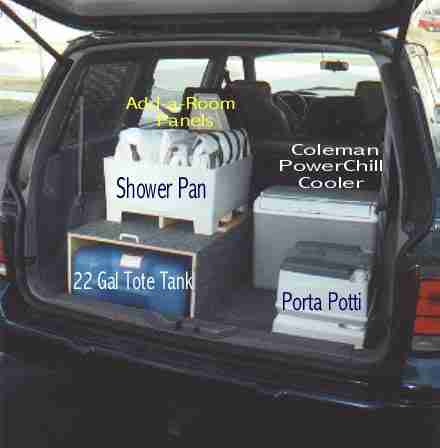
|
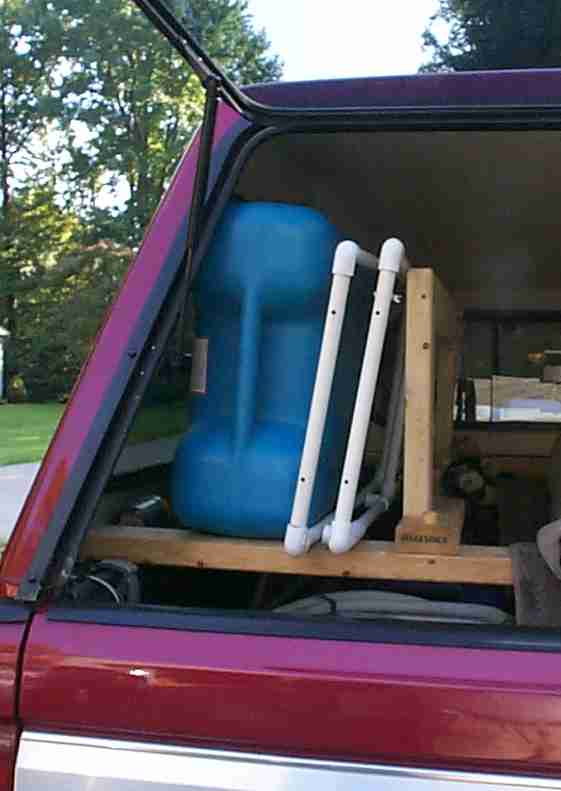 |
I have the luxury of space in the bed of our tow
vehicle. Here you see I have added a vertical brace to my rack
system to support the gray water container and my shower
stand (that's the white PVC thing). |
| If necessary, I could transport even the 22
gallon gray water tank in the aisle of my Santa Fe. If you are going
to transport this way, measure your aisle before
you buy the tank. Measure the tank at it's widest point to see if it
would fit. On my tank the widest point is the hubs on the ends of
the tank axle. If I were going to transport this way these tips
would need to be padded to keep from rubbing in the cabinets during
transport.
When you measure the aisle, remember to take restricting items into
account like drawer handles.
|
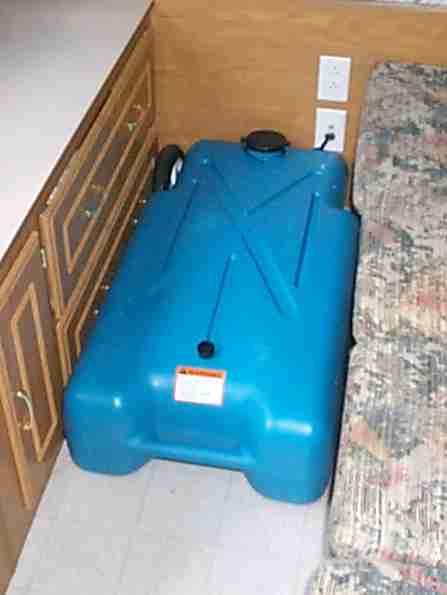 |
My tank was manufactured by: Barker
Manufacturing Company

**********************************************
Confused over Gray Water?
Gray water is a term which is legally defined state by state
as well as a term used by the RV industry to identify the contents of one of the
two waste tanks on onRV.
Thus you have numerous "definitions" of what gray water is and
depending on who is speaking it can make a big difference. Confusion
arises because the RV industry considers kitchen sink waste "gray
water" while the EPA and most state health departments consider it
sewage. To add to the confusion many communities advocate the practice of
reusing/recycling gray water for landscape use. Do not let this confuse
you, when talking about gray water recycling they normally exclude water from a
food preparation sink.
The easiest legal definition I found on line was the Arizona
definition:
R18-9-701(4) “Gray water” means wastewater collected
separately from a sewage flow that originates from a clothes washer, bathtub,
shower, and sink, but does not include wastewater from a kitchen sink,
dishwasher, or toilet.”
This is similar to most state laws I have read on the issue
and I point out that they exclude water from a kitchen sink. Well, if it is not
gray water what is the water that comes out of your sink? It's legally sewage!
As it has been explained to me kitchen sink waste contains solids including
grease, and food particles that are not normal found in the wastewater from a hand washing
sink.
When you think about it, kitchen sink waste is the majority
of the water from a pop up. Many pop up campers moved up from tent
camping where washing the dishes in a pan and then dumping the water in the
bushes is common and accepted practice. But, when we deal with the
issue of dumping gray water on the ground from pop ups we can't look at the
discharge from a single camper, but the combined discharge of all the campers
who will use a single campsite over a camping season or longer. Many people feel
"soapy water, in moderation, actually helps in soil emulsification",
which is technically correct, but there is a difference in the amount you
may spray on your lawn and the amount 40 or 50 campers will dump on a single
campsite over a season if they don't collect and dispose of it properly. Without
gray water containment we will have a concentration of soap and other residues
dumped in a very small location.

Revised: May 08, 2007
|